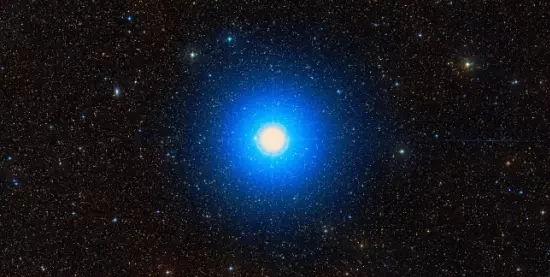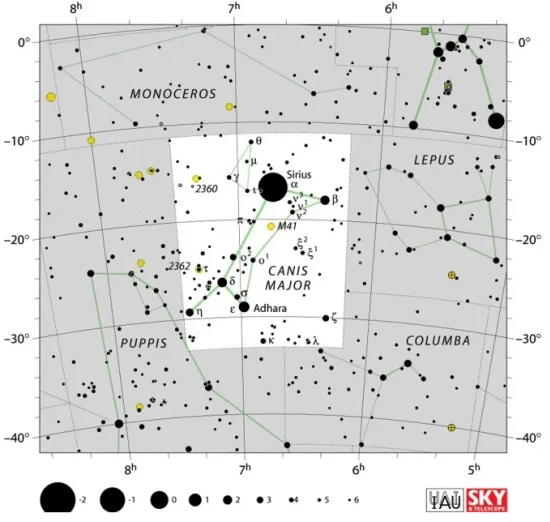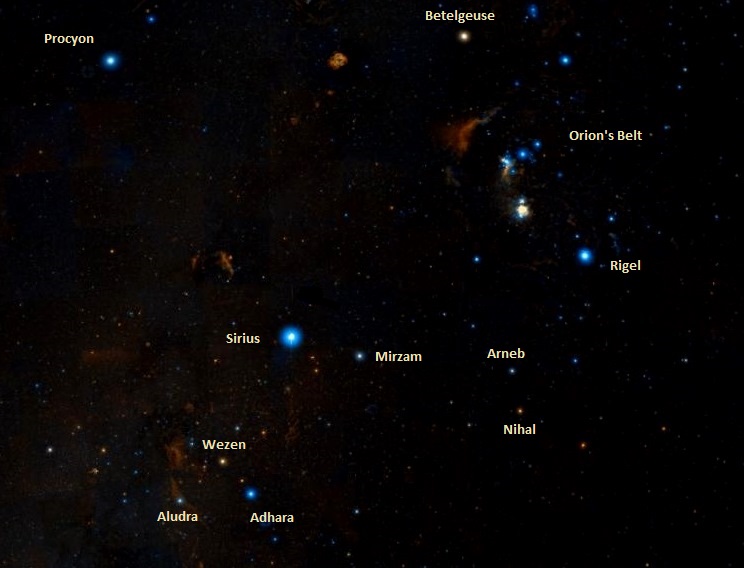Adhara, Epsilon Canis Majoris (ε CMa), is a binary star system located in the constellation Canis Major. It lies at a distance of 430 light years from Earth. With an apparent magnitude of 1.50, it is the second brightest star in Canis Major, after Sirius, and the 22nd brightest star in the sky. It is slightly brighter than Castor in Gemini, Shaula in Scorpius and Gacrux in Crux, but outshined by Deneb in Cygnus, Mimosa in Crux and Regulus in Leo.
Star system
Epsilon Canis Majoris is a binary star system consisting of Epsilon Canis Majoris A, a bright giant, and Epsilon Canis Majoris B, a faint companion at a separation of 7.5 arcseconds from the primary. Even though the angular distance between the components is considerable, the two stars can only be resolved in large instruments because Epsilon CMa A is about 250 times brighter than Epsilon CMa B.
Epsilon Canis Majoris A is a bright giant of the spectral type B2 II, appearing blue-white in colour. With a surface temperature of 22,900 K, it shines with a luminosity 38,700 times that of the Sun and has an absolute magnitude of -4.8. However, because of its high temperature, it radiates a significant portion of its energy output in the invisible ultraviolet part of the spectrum. The star has the size 13.9 times that of the Sun and about 12.6 solar masses, enough to make it a supernova candidate. The star’s estimated age is 22.5 million years.

Adhara (Epsilon Canis Majoris), image: Wikisky
The companion has an absolute magnitude of 1.9 and an apparent magnitude of 7.5. It lies at least 900 astronomical units from the primary, which means that the stars take at least 7,500 years to complete an orbit.
Facts
Adhara was the brightest star in the sky 4.7 million years ago, when it came within 34 light years of the Sun. It had a visual magnitude of -3.99, outshining Jupiter (mag. -2.94 to -1.66), Mercury (mag. -2.48 to +7.25), Mars (mag. -2.94 to +1.86) and occasionally even Venus (mag. -4.92 to -2.98). It was two and a half magnitudes brighter than Sirius is today (mag. -1.46). The only historical brightest star that came even close to reaching that magnitude is Adhara’s neighbour Mirzam (β CMa), which had an apparent magnitude of -3.65 about 4 million years ago.
With an apparent magnitude of 1.50, Adhara is right on the border between first and second magnitude. It is mentioned as the faintest first-magnitude star by some sources and as the brightest second-magnitude star by others.
Adhara and Sirius are included on the list of the 58 stars selected for navigation. Navigational stars have a special status in the field of celestial navigation because they are some of the brightest and most recognizable stars in the sky.
Adhara is the brightest known extreme ultraviolet source in the sky. If we could see in ultraviolet wavelengths, it would outshine all the other stars. A study published In 1995 found the star to be the strongest source of Lyman continuum photons (photons emitted above the Lyman limit, capable of ionizing hydrogen atoms in the nearby gas), one that plays an important role in the ionization of hydrogen in the Local Interstellar Cloud (the interstellar cloud stretching across 30 light years, through which the Sun is moving).
Adhara is one of the stars that appear on Brazil’s national flag. Each star featured on the flag represents a Brazilian Federative Unit and Adhara symbolizes the state of Tocantins.
Name
The star’s traditional name is derived from the Arabic Al Adhara, meaning “maidens” or “virgins.” It has also been spelled Adara, Udara, Udra or Adard. The 17th century Egyptian astronomer Al Achsasi al Mouakket designated the star Aoul al Adzari, “the first of the virgins,” in his Calendarium. The name was later translated into Latin as Prima Virginum. Adhara, Wezen (Delta Canis Majoris), Aludra (Eta Canis Majoris) and Omicron2 Canis Majoris (listed by Al Achsasi al Mouakket as Thanih al Adzari) were collectively known as Al ʽAdhārā, “the Virgins.”
The name Adhara formally applies only to Epsilon Canis Majoris A, but is commonly used for the entire star system. It was officially approved by the International Astronomical Union’s (IAU) Working Group on Star Names (WGSN) on August 21, 2016.
The Chinese know the star as 弧矢七 (Hú Shǐ qī), or the Seventh Star of Bow and Arrow. Bow and Arrow is a Chinese asterism formed by Adhara with Wezen (δ CMa), Aludra (η CMa), Kappa Canis Majoris, c Puppis, Chi Puppis, Omicron Puppis, k Puppis, and Pi Puppis.
Location
Adhara is located in a region of the sky populated by a number of other exceptionally bright stars. These include Sirius, Procyon, Pollux and Castor, Rigel, Betelgeuse and the stars of Orion’s Belt. Marking one of the hind legs of Canis Major, Adhara is easy to find because it is the brightest of the three relatively bright stars located under Sirius. Sirius is easy to identify, both because it is brighter than any other star in the sky and because the stars of Orion’s Belt – Alnitak, Alnilam and Mintaka – point directly at it.
Adhara forms a triangle with fellow “virgins” Wezen (Delta CMa) and Aludra (Eta CMa), and marks the lower right vertex of the triangle.
Constellation
Adhara is located in the constellation Canis Major. Representing the larger of the two dogs following Orion, the Hunter, Canis Major is home to a number of interesting stars, including Sirius, the brightest star in the sky, the yellow-white supergiant Wezen, the blue giant (or bright giant) Mirzam, the blue-white supergiant Aludra, and the red supergiant (or hypergiant) VY Canis Majoris, one of the largest stars known.

Canis Major constellation map by IAU and Sky&Telescope magazine
Notable deep sky objects in Canis Major include the open clusters Messier 41 and Caroline’s Cluster (NGC 2360), the interacting galaxies NGC 2207 and IC 2163, and the Canis Major Dwarf, the nearest Milky Way satellite to Earth.
The best time of year to observe the stars and deep sky objects in Canis Major is during the month of February.
The 10 brightest stars in the constellation are Sirius (Alpha CMa, mag. -1.46), Adhara (Epsilon CMa, mag. 1.50), Wezen (Delta CMa, mag. 1.824), Mirzam (Beta CMa, mag. 1.985), Aludra (Eta CMa, mag. 2.45), Furud (Zeta CMa, mag. 3.025), Omicron2 Canis Majoris (mag. 3.043), Unurgunite (Sigma CMa, mag. 3.43 – 3.51), Kappa Canis Majoris (mag. 3.40 – 3.97), and Omicron1 Canis Majoris (mag. 3.78 – 3.99).
Adhara – Epsilon Canis Majoris
| Spectral class | B2II |
| U-B colour index | –0.93 |
| B-V colour index | –0.21 |
| Apparent magnitude | 1.50 (A), 7.5 (B) |
| Absolute magnitude | -4.8 (A), +1.9 (B) |
| Distance | 430 ± 30 light years (132 ± 10 parsecs) |
| Parallax | 7.57 ± 0.57 mas |
| Radial velocity | +27.3 km/s |
| Proper motion | RA: +2.63 mas/yr |
| Dec.: +2.29 mas/yr | |
| Mass | 12.6 ± 1.0 M☉ |
| Luminosity | 38,700 L☉ |
| Radius | 13.9 R☉ |
| Temperature | 22,900 K |
| Age | 22.5 ± 2.6 million years |
| Rotational velocity | 25 km/s |
| Surface gravity | 3.39 cgs |
| Constellation | Canis Major |
| Right ascension | 06h 58m 37.6s |
| Declination | –28° 58′ 19″ |
| Designations | Adhara, Epsilon Canis Majoris, ε CMa, 21 Canis Majoris, HR 2618, HD 52089, HIP 33579, GC 9188, GCRV 4590, FK5 268, SAO 172676, CD−28°3666, ADS 5654, CCDM J06586-2858A, IRAS 06566-2854, 2MASS J06583754-2858197, PPM 251347, TYC 6535-3619-1 |
